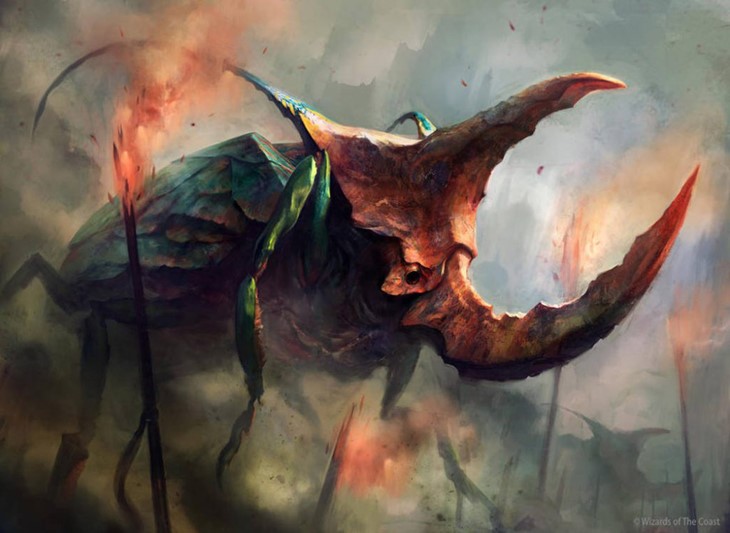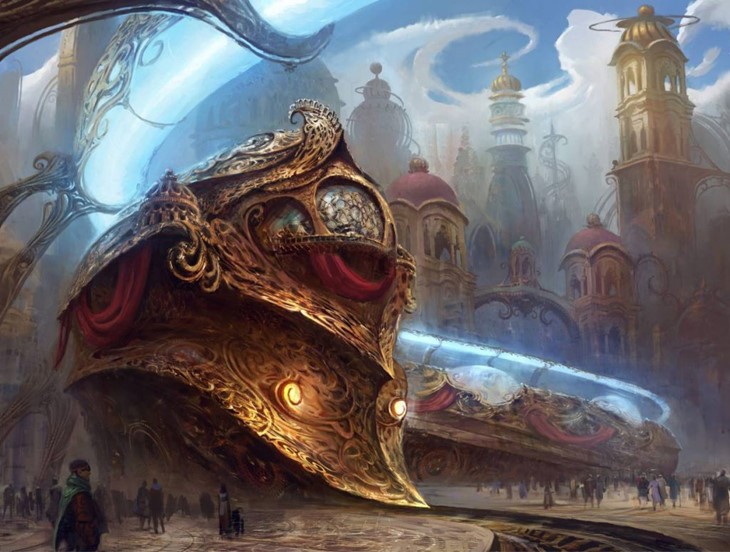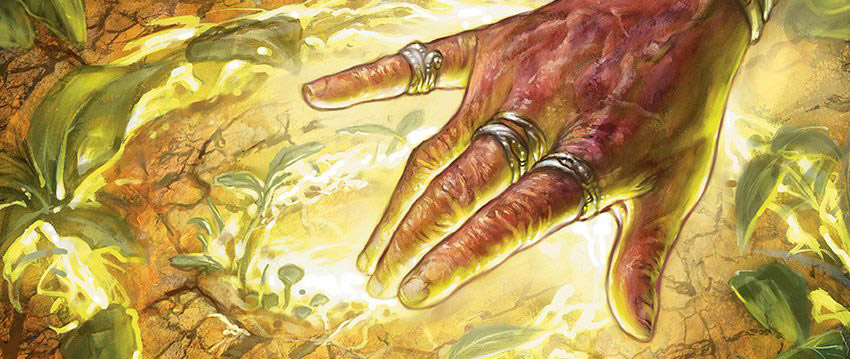Adam Paquette Interview
Welcome to our MTG Artists Interview series There’s no Magic without art.
For this week’s interview, we talked with Adam Paquette, who has been working on the game since 2012 and painted over 144 Magic cards so far.

Hi Adam. Tell us a bit about how you got started with illustration and with Magic.
Compared to many artists in similar fields, I started quite late in terms of visual exploration. Until the end of high school, I primarily focused my creativity on imaginative writing. I grew up with parents who were actively engaged with leaders and storytellers from different cultures, and I spent a big part of my young life living in India, so my mind was a playground for overlapping narratives and the textures of these different interactions.
Of course, many of these flights of fancy were visual in nature, and I remember struggling with extraordinarily long sentences and paragraphs in my writing, trying to explain through words the complicated, rich images I was imagining. Late in high school, I stumbled upon some online communities centered around concept art, which I had not previously been aware of – and this captured my enthusiasm entirely.
I decided to refocus my energy on visual art, as I saw a potential career path there, and I also loved the immediacy of the feedback loop withdrawing; people could tell you instantly what they thought of your work, without having to take hours to read through it. I still consider myself primarily ‘narrative’ in tendency, but I have worked primarily in visual media since then.
As far as Magic, specifically, I was already working for WOTC on D&D around 2009, when I visited the Illustration Masterclass in Amherst, MA and met Magic’s then-head AD – Jeremy Jarvis.

We spoke a little about my primary focus on landscape painting and relative weakness with figures, and he agreed to take me on board first as a concept artist (working on Innistrad) and then as a card artist shortly afterward – focusing on land cards.
Eventually, he opened me up to creature and character commissions as I had time to improve my skills. I was very impressed by both the support of the magic art team in giving me room to improve, and also being clear about my strengths and weaknesses, and what they needed from me.
What artists inspired you the most?
My influences have changed significantly over time. As a child, I was inspired by the various lived cultures I saw around me – and didn’t really consider a difference between ‘art’ and the rest of life, lived creatively. As a teenager, I became more interested in museums and galleries, as well as developed a small obsession with visiting artists’ studios and seeing into their lives and minds. I was impressed with these romantic lifestyles.
Brett Whitely and his Sydney studio were a big influence, Toulouse-Lautrec and the life of the Paris artists and cafés, and so on. When I first began to see the potential of working as an illustrator, I became aware of many of the artists leading the way with digital painting and fell in love with the work of Craig Mullins, Justin Sweet, Vance Kovacs, James Jean, and many, many others who I came into contact with through forums and online spaces.
Through investigating their work and influences, I was made aware of the 19th century Academic painters like Bougereau, and the painters who were taking their knowledge and extending it into painting from life and on location; Sargent, Zorn, and the Impressionists. From then on, I always shared an interest in both Illustrators working efficiently in current, often digital, media – and a strong attachment to the history of ‘real’ painting (as I thought of it).

I became aware of and traveled to meet with, many painters who I saw as a precious link to this history: Golucho, Antonio Lopez Garcia, Patrick Devonas, Christopher Pugliese, and Vincent Desiderio. Aside from my actual fine art practice of painting which I continue to carry forward, I also try to bring this spirit of painting and its history into the world of illustration. Today my influences have expanded even further into contemporary and conceptual art, installation, dance, and music.
Can you briefly describe your illustration process?
My process for creating art varies wildly depending on the client and project. For Magic, though, it is fairly consistent. I begin by receiving the brief from WOTC, and before I look at any reference, I spend a few hours thumbnailing out ideas and letting my imagination freely associate with the brief. I usually find ideas that excite me pretty quickly – and this is one of the most enjoyable parts of the process.
Then I usually take my favorite sketches and alongside those, I look at whatever work is currently inspiring me – maybe something I saw on Instagram or Facebook. I think about how I could learn from these works and use my Magic work as a place to try out some new ideas – maybe a new way of mark-making, a color palette, a compositional idea, etc. I rework my sketches with that goal in mind – how does this piece let me learn something? (At the moment, it is often an excuse to learn 3D).
Then I use my sketch as a reference and begin immediately in photoshop, building out the composition in big simple shapes. I send off the sketch, and once I receive feedback I use a mixture of direct painting, photo bashing, 3d – basically whatever works – to establish and strengthen the lighting, color, composition, and general power of the image. The last part of the process is always the most ‘painterly’ as I want to make sure the final image always has the feel of human touch.

What makes for an interesting art description?
For the most part, Magic consists of larger-than-life spells, action, and environment design. For good reason, there is a focus on world-building through compelling and dramatic imagery – This is especially important due to Magic being a paper card game, played in the field of films and video games.
‘Moments of repose’, as they are called internally, are few and far between, but I enjoy these the most – my recent Sai, Master Thopterist, the Forest basic from Return to Ravnica or even Soul of Innistrad come to mind. Another thing that is always enjoyable is when the art directors point to different artworks in the history of painting as a reference for a mood or visual idea – riffing off that history, and working with art directors who also have a passion for it, adds a welcome level of depth.
What were the most challenging cards to work on?
It is usually difficult to know how challenging a card will be before I start. Ideas come easy for me, and I can quickly enter into a particular atmosphere and explore a world in my imagination. The difficulty comes generally from issues of perspective and framing, where there is complex problem-solving required in order to meet the brief, communicate well, be unique, and conform to the rules of realism.
I would actually say that, overall, the challenge level remains fairly consistent – because as I improve my skills, I tackle more ambitious ideas for images. Some of my work on upcoming sets was a particularly difficult mix of architecture that I had to learn some new 3D skills in order to approach the way I wanted to… There was also a tricky set for me to get my head around a few years back, even though I was on the concept team – I just didn’t find the world as easy to immerse my imagination in.

Recently, Mending of Dominaria was a surprisingly tricky one to nail – making the characters read as figures, whilst also making the object feel like a wooden sculpture, and conveying enough of the ‘setting’ through a blurry background was a delicate balance.
Half the cards you painted for Magic were lands, and I feel that there’s a mist that envelops these landscapes, devoid of figures or characters, in a mysterious, almost haunted mood. Do you agree with my assessment?
It’s really hard, for any artist I think, to explain what works and doesn’t in their own images. Having such an enthusiastic and far-reaching community around Magic is hugely helpful to me because it gives me a regular chance to engage with my audience and get an idea of what they notice about my images. Most of the time their comments are about this light and atmosphere in some form or another.
Over time I have come to understand this aspect of my paintings and I think I know what people are responding to, but it isn’t exactly something I can say is intentional. I would take guess that it comes as an organic result of my painting method. Every artist works differently, uses different tools, and does things in a different order. This unique approach to solving a problem is what people usually refer to as ‘style’.
You can’t premeditate it, it is emergent. The way I paint digitally comes from the way that I draw and paint in traditional media – I usually like to work without reference or a clear plan, and I kind of ‘Rorschach’ my way into an idea through soft, random scribbling until an image emerges. A lot of my cards are done the same way – beginning with a vague sketch of an idea, then dissolving it into ‘soup’ and slowly carving back into that intuitively to find the form, and then bring it to a resolution.

As my personal work and oil painting develop though, I am seeing a definite focus on the light itself (beyond just using it to create realism) – as a metaphor and a kind of conceptual anchor to hang the technique off. It’s an ongoing research project, into myself, I guess!
Do you feel that working on Magic also influences your personal work? If so, in which ways?
Honestly, I wouldn’t say it does. My personal work is at the core of who I am and reflects my ongoing investigations into myself and the life around me – it is always changing, often experimental, and rarely applicable to the work I do. Commercial work, Magic included, relies on my professional ability to understand what the audience of each game or film is interested in and bring my skills to bear on doing the best job I can of fulfilling that need.
I used to try to bring a lot more of ‘myself’ into this commercial work, but I found over time that not only was I putting that personal overtime into someone else’s ‘world’ rather than my own, but it also got in the way of me being a good problem solver for my clients. I pushed too hard to include my own tastes and preferences in the work, and it just cost me the extra time I could have been working on my own thing – and set me back into revisions with my clients.
I now have a healthy separation between these two halves of my creative practice, and I try to be efficient and effective in my work for Magic, so I can spend the rest of my time looking after myself, my art, and the people I care about.
Do you consider doing some traditional media work for Magic in the future?
Due to the high demand for Magic originals, I have, over the years, done some one-off ‘repaints’ for collectors, turning my digital pieces into oils. I have 3 of these currently on the easel. As for doing new cards in oils, I never felt comfortable enough applying the oil painting process to the timeline of illustration, especially since I usually work on a lot of cards concurrently.

I would certainly never rule it out, but as above, it is probably extra time that I would rather devote to my own development. I also enjoy digital work and learning more about 3D software, so Magic keeps my foot in that world in a way I wouldn’t like to compromise.
What’s the potential of 3D comparing to other mediums?
3D is still a supplementary medium for me, I use it mostly to establish solid foundations on top of which the painting can sit. 3D extends my abilities and allows me to tackle more ambitious ideas – especially complicated architectural compositions or lighting situations.
I’m not a huge fan of spending long hours at the computer, so I am wary of indulging too much in learning new software – but I’m getting to the point where time invested in learning is paying off and speeding up my painting process to get to a better result faster.
Not to mention that it won’t be long before 3d/vr are the mainstream norm for this kind of work and 2d-only will fall behind just like traditional-only did. I really believe in the power of traditional painting and sculptural media, but rather than choosing one or the other, I’d like to find time to pursue both extremes and see what magic happens in the middle. I’d love to know high-end 3D and combine that with traditional oil painting, for instance, to see what happens in that space.
You painted six cards for the newly released Guilds of Ravnica, how did it feel to work to return to such an iconic setting for the game, considering you also worked on both Gatecrash and Dragon’s Maze?
Ravnica is a really interesting place for me to visit. My parents separated when I was 6, and my father moved into the city while my mother stayed out in a semi-rural area with lots of nature. Spending time in both of these places gave me a balanced love for both environments – and in Ravnica, it is a joy to explore combining them as if I were finding the harmony between two halves of my childhood. Now that I moved from Australia to Berlin, I have an even deeper appreciation of European city life, aesthetics, and cultural subtleties.
Even though cities aren’t the healthiest place to live, I find the atmosphere, stimulation, and constant unexpected surprises contribute so much to my mental well-being that I find myself always drawn back to these cultural hubs. I do have to say that painting an urban environment does get tricky, and I did a significant amount of work on the new Ravnica, so it will be refreshing to shift gears hopefully into something more ‘organic’ in nature!

That’s an interesting aspect of how your personal life and work permeate your Commercial work. Have other planes evoked similar responses and memories?
In fact, yes. A few years ago I was asked to help out on the concept push for Kaladesh, a world loosely based around many of the aesthetic elements of traditional Indian art and culture. I actually spent several years in India when I was very young, and that part of my life deeply affected me and my tastes as an artist. I had many dreams of that time over the years, and my real memories blended in with my imagined ones and I created an idea of an archetypal ‘India’ from my childhood without ever seeing it again.
When it came time to help concept Kaladesh, it reawakened all of these latent imaginations and it was very exciting – although brief – to work on that. Not long afterward I returned to India for the first time in about 25 years. The reality, of course, was starkly juxtaposed against the backdrop of my own fantasy – and that in itself brought up a fascinating and complex series of questions for me; about the nature of art, illustration, and its connection to the world we live in.
Of the work you made for Magic, can you name some favorites?
I have two favorite pieces for Magic: The one I just finished, and the one I’m just about to start. My least favorite is the one I’m working on at the time! In all seriousness, it is difficult to choose a favorite, because I don’t really see them as a finished painting, I see them as a complex combination of process, frustration, input, the things going on in my life at the time – and then maybe the result itself.
The ones I think are ‘successful’ often go unnoticed by fans, and the ones I am most frustrated with become the most popular (often simply due to good card mechanics). Should I like a piece because I’m happy with it, or because my audience is happy with it? A few of the cards I remember being pleased with at the time I finished them were:
My first card (Island, Innistrad), Command Tower, Basic Forest/Ravnica, Full art basics from Battle for Zendikar, and Jace’s Sanctum.

We thank Adam for his time and kindness.
You can learn more about Adam’s paintings on his website . He also hangs out on Twitter, Instagram and Facebook.
You can also order some cool prints from Adam here.
Recommended Posts

Adam Paquette Interview
Welcome to our MTG Artists Interview series There's no Magic without art. For this week's interview, we talked with Ad
Read More
Anson Maddocks Interview
Welcome to our MTG Artists Interview series There's no Magic without art. We're very happy to share with you our talk
Read More
Anthony Palumbo Interview
Welcome to our Artists Interview series - There's no Magic without art - where we talk to artists about their work on
Read More